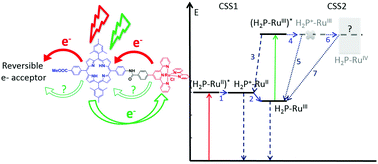Photoinduced electron transfer in a molecular dyad by nanosecond pump–pump–probe spectroscopy†
Abstract
The design of robust and inexpensive molecular photocatalysts for the conversion of abundant stable molecules like H2O and CO2 into an energetic carrier is one of the major fundamental questions for scientists nowadays. The outstanding challenge is to couple single photoinduced charge separation events with the sequential accumulation of redox equivalents at the catalytic unit for performing multielectronic catalytic reactions. Herein, double excitation by nanosecond pump–pump–probe experiments was used to interrogate the photoinduced charge transfer and charge accumulation on a molecular dyad composed of a porphyrin chromophore and a ruthenium-based catalyst in the presence of a reversible electron acceptor. An accumulative charge transfer state is unattainable because of rapid reverse electron transfer to the photosensitizer upon the second excitation and the low driving force of the forward photodriven electron transfer reaction. Such a method allows the fundamental understanding of the relaxation mechanism after two sequential photon absorptions, deciphering the undesired electron transfer reactions that limit the charge accumulation efficiency. This study is a step toward the improvement of synthetic strategies of molecular photocatalysts for light-induced charge accumulation and more generally, for solar energy conversion.

- This article is part of the themed collection: 28th International Conference on Photochemistry (ICP 2017)


 Please wait while we load your content...
Please wait while we load your content...